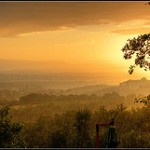Some of the first archived references to the village of Vorno date back from 944 when Padre Cianelli mentions the church of San Pietro in “Memorie Lucchesi”. The valley and surrounding hills were battlefields for over 400 years during the many wars between Lucca and Pisa and other archived references date around 1148 when the Lucchese people seized the castle of Vorno from the Pisans (it was to pass between the two sides many times before finally being destroyed). Ruins of other fortified castles and buildings, however, are testimony to an area immersed in history – a history that began even before the arrival of the Romans.
Between the end of the 13th and throughout the 14th century, this history of Vorno was turbulent with the onset of famine, the plague, the battles between Pisa and Lucca and the raiding of the countryside by bandits which caused many families to flee the area.
The most radical transformation came at the beginning of the 15th century when several of the most important families in the area (Trenta, Tegrimi, Garbesi, Mansi, Busdraghi, Sbarra, Gualanducci) created a modern and functional farming system where land was divided up. This original division of land still remains intact today. A progressive transformation of the area continued until the end of the 1700, which made Vorno one of the most bustling centres on the Lucchese plains, especially in summer when the nobility moved (with family, friends, guests and servants) from their homes in the city of Lucca to the countryside of Vorno where the temperature was certainly cooler. In 1793 the church of Vorno, now considered too small and “lacking in prestige”, was enlarged under the charge of Giovan Battista Petri who changed and made higher the façade and the central porticles. On completion the Comune di Vorno did not have sufficient funds to pay for the changes and therefore had to sell some of its properties and possessions to cover the debt.
With the abolition of the rural community at the start of the 1800 Vorno was united with Cantone di Compito and then the Municiple of Massa Pisana, then again with Compito until in 1819, when, with the administrative reorganisation of Maria Luisa di Borbone, it passed indefinitely to the Comune di Capannori.
During the 1800’s the population continued to grow and in 1920 there were a total of 1600 inhabitants. Already from the start of 1800 the main income was as a washerwoman – a hard and tiring work but very significant as they washed for all the city of Lucca as well as the surrounding plains. The quality of the water, famous for its lightness, was of great importance but certainly the washerwomen of Vorno were also well renowned for their skill. The washing would be collected in large baskets called “concari” and then cleaned in the Vorno river, beaten with heavy mallets made from wood. Every Monday, after having loaded the baskets onto carts, the washerwomen would make their way to Lucca to drop off the clean laundry and pick up the next wash. In 1808 in Vorno there were 80 washerwoman, in 1824 230 and in 1860 more than 250.
The 1800’s brought about newness and social change. Renowned people came to reside in the area – Francesco Carrara (a well know jurist and political man), Lorenzo Nottolini (famous architect responsible for the acquaduct and the Anfiteatro in Lucca), Felice Matteucci (inventor of the stroke engine), G Battista Mansi, Carlo Controni, Carlo Minutoli and many others.
In 1862 the elementary school opened and then in 1870 the sisters “Dorotee” opened a school for girls in Villa Mansi. In 1901 an aquaduct was built to supply the many local fountains linked to the spring of Borgognone in Valle. Today Vorno is sometimes referred to as “little Switzerland” because of its extraordinary ambience, countryside and superfluous supply of spring water.
Villa al Boschiglia dates back to the first half of the 17th century, complying to the characteristics of a typical Lucchese villa built on 3 floors with a large central room surrounded by 4 symmetrical smaller rooms. It was built as a summer residence for the nobility who lived in palazzos in the centre of the old city of Lucca during the winter and spent the summer in the low lying hills around Lucca where temperatures were a couple of degrees cooler. The estate at one time also encompassed its own chapel, olive press and servants quarters.




